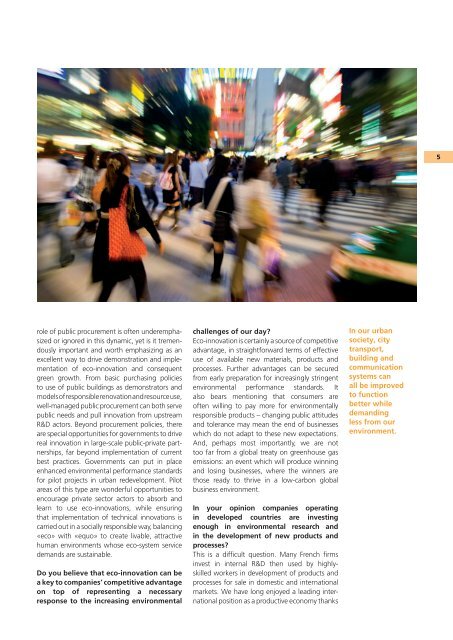SD Vision - Halyps Cement
SD Vision - Halyps Cement
SD Vision - Halyps Cement
Create successful ePaper yourself
Turn your PDF publications into a flip-book with our unique Google optimized e-Paper software.
ole of public procurement is often underemphasized<br />
or ignored in this dynamic, yet is it tremendously<br />
important and worth emphasizing as an<br />
excellent way to drive demonstration and implementation<br />
of eco-innovation and consequent<br />
green growth. From basic purchasing policies<br />
to use of public buildings as demonstrators and<br />
models of responsible renovation and resource use,<br />
well-managed public procurement can both serve<br />
public needs and pull innovation from upstream<br />
R&D actors. Beyond procurement policies, there<br />
are special opportunities for governments to drive<br />
real innovation in large-scale public-private partnerships,<br />
far beyond implementation of current<br />
best practices. Governments can put in place<br />
enhanced environmental performance standards<br />
for pilot projects in urban redevelopment. Pilot<br />
areas of this type are wonderful opportunities to<br />
encourage private sector actors to absorb and<br />
learn to use eco-innovations, while ensuring<br />
that implementation of technical innovations is<br />
carried out in a socially responsible way, balancing<br />
«eco» with «equo» to create livable, attractive<br />
human environments whose eco-system service<br />
demands are sustainable.<br />
Do you believe that eco-innovation can be<br />
a key to companies’ competitive advantage<br />
on top of representing a necessary<br />
response to the increasing environmental<br />
challenges of our day?<br />
Eco-innovation is certainly a source of competitive<br />
advantage, in straightforward terms of effective<br />
use of available new materials, products and<br />
processes. Further advantages can be secured<br />
from early preparation for increasingly stringent<br />
environmental performance standards. It<br />
also bears mentioning that consumers are<br />
often willing to pay more for environmentally<br />
responsible products – changing public attitudes<br />
and tolerance may mean the end of businesses<br />
which do not adapt to these new expectations.<br />
And, perhaps most importantly, we are not<br />
too far from a global treaty on greenhouse gas<br />
emissions: an event which will produce winning<br />
and losing businesses, where the winners are<br />
those ready to thrive in a low-carbon global<br />
business environment.<br />
In your opinion companies operating<br />
in developed countries are investing<br />
enough in environmental research and<br />
in the development of new products and<br />
processes?<br />
This is a diffi cult question. Many French fi rms<br />
invest in internal R&D then used by highlyskilled<br />
workers in development of products and<br />
processes for sale in domestic and international<br />
markets. We have long enjoyed a leading international<br />
position as a productive economy thanks<br />
In our urban<br />
society, city<br />
transport,<br />
building and<br />
communication<br />
systems can<br />
all be improved<br />
to function<br />
better while<br />
demanding<br />
less from our<br />
environment.<br />
5


